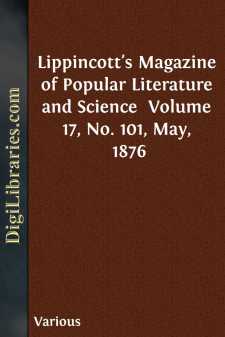Categories
- Antiques & Collectibles 13
- Architecture 36
- Art 48
- Bibles 22
- Biography & Autobiography 813
- Body, Mind & Spirit 142
- Business & Economics 28
- Children's Books 17
- Children's Fiction 14
- Computers 4
- Cooking 94
- Crafts & Hobbies 4
- Drama 346
- Education 46
- Family & Relationships 57
- Fiction 11829
- Games 19
- Gardening 17
- Health & Fitness 34
- History 1377
- House & Home 1
- Humor 147
- Juvenile Fiction 1873
- Juvenile Nonfiction 202
- Language Arts & Disciplines 88
- Law 16
- Literary Collections 686
- Literary Criticism 179
- Mathematics 13
- Medical 41
- Music 40
- Nature 179
- Non-Classifiable 1768
- Performing Arts 7
- Periodicals 1453
- Philosophy 64
- Photography 2
- Poetry 896
- Political Science 203
- Psychology 42
- Reference 154
- Religion 513
- Science 126
- Self-Help 84
- Social Science 81
- Sports & Recreation 34
- Study Aids 3
- Technology & Engineering 59
- Transportation 23
- Travel 463
- True Crime 29
Lippincott's Magazine of Popular Literature and Science Volume 17, No. 101, May, 1876
by: Various
Description:
Excerpt
THE CENTURY—ITS FRUITS AND ITS FESTIVAL.
V.—MINOR STRUCTURES OF THE EXHIBITION.
FOUNTAIN OF THE CATHOLIC TOTAL ABSTINENCE UNION.Compress it as you may, this globe of ours remains quite a bulky affair. The world in little is not reducible to a microscopic point. The nations collected to show their riches, crude and wrought, bring with them also their wants. For the display, for its comfort and good order, not only space, but a carefully-planned organization and a multiplicity of appliances are needed. Separate or assembled, men demand a home, a government, workshops, show-rooms and restaurants. For even so paternal and, within its especial domain, autocratic a sway as that of the Centennial Commission to provide all these directly would be impossible. A great deal is, as in the outer world, necessarily left to private effort, combined or individual.
Having in our last paper sketched the provision made by the management for sheltering and properly presenting to the eye the objects on exhibition, we shall now turn from the strictly public buildings to the more numerous ones which surround them, and descend, so to speak, from the Capitol to the capital.
Our circuit brought us back to the neighborhood of the principal entrance. Standing here, facing the interval between the Main Building and Machinery Hall, our eyes and steps are conducted from great to greater by a group of buildings which must bear their true name of offices, belittling as a title suggestive of clerks and counting-rooms is to dimensions and capacity exceeding those of most churches. Right and left a brace of these modest but sightly and habitable-looking foot-hills to the Alps of glass accommodate the executive and staff departments of the exposition. They bring together, besides the central administration, the post, police, custom-house, telegraph, etc. A front, including the connecting verandah, of five hundred feet indicates the scale on which this transitory government is organized. Farther back, directly opposite the entrance, but beyond the north line of the great halls, stands the Judges' Pavilion. In this capacious "box," a hundred and fifty-two by a hundred and fifteen feet, the grand and petit juries of the tribunal of industry and taste have abundant elbow—room for deliberation and discussion. The same enlightened policy which aimed at securing the utmost independence and the highest qualifications of knowledge and intelligence in the two hundred men who determine the awards, recognized also the advantage of providing for their convenience. Their sessions here can be neither cramped nor disturbed. So far as foresight can go, there is nothing to prevent their deciding quietly, comfortably and soundly, after mute argument from the vast array of objects submitted to their verdict, on the merits of each. The main hall of this building, or high court as it may be termed, is sixty by eighty feet, and forty-three feet high. In the rear of it is a smaller hall. A number of other chambers and committee-rooms are appropriated to the different branches as classified....












